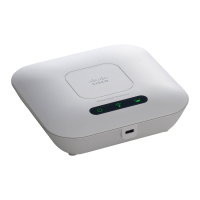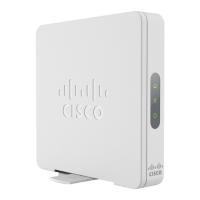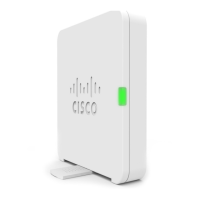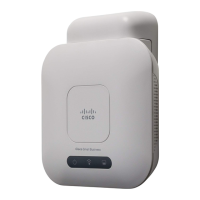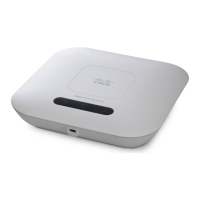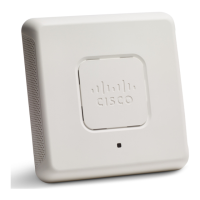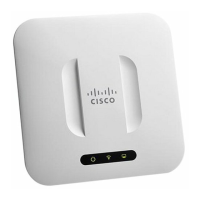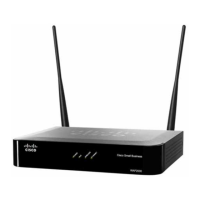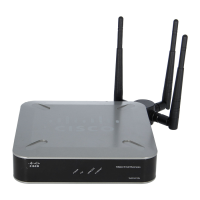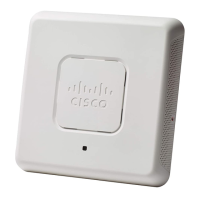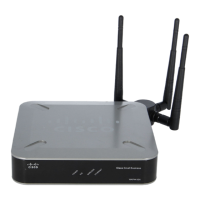If you enable RADIUS accounting, it is enabled for the primary RADIUS server, all backup servers, and
all configured servers.
• Server IP Address-1 or Server IPv6 Address-1— Enter the IPv4 or IPv6 address for the primary RADIUS
server for this VAP. The IPv4 address should be in a form similar to xxx.xxx.xxx.xxx (192.0.2.10). The
IPv6 address should be in a form similar to xxxx:xxxx:xxxx:xxxx:xxxx:xxxx:xxxx:xxxx
(2001:DB8:CAD5:7D91).
When the first wireless client tries to authenticate with a VAP, the WAP device sends an authentication
request to the primary server. If the primary server responds to the authentication request, the WAP device
continues to use this RADIUS server as the primary server, and the authentication requests are sent to the
specified address.
Server IP Address-2 or Server IPv6 Address-2 —Enter up to three IPv4 or IPv6 backup RADIUS server
addresses. If the authentication fails with the primary server, each configured backup server is tried in
sequence.
• Key-1— Enter the shared secret key that the WAP device uses to authenticate to the primary RADIUS
server. You can use up to 63 standard alphanumeric and special characters. The key is case sensitive and
must match the key configured on the RADIUS server. The text that you enter is shown as asterisks.
Key-2—Enter the RADIUS key associated with the configured backup RADIUS servers. The server at
Server IP Address-1 uses Key-1, Server IP Address-2 uses Key-2, and so on.
• No Authentication — The users do not need to be authenticated by a database.
• 3rd Party Credentials — The WAP device uses the credentials on the social media to authenticate the users.
Configure the following if using 3rd Party Credentials authentication setting.
• Accepted credentials — Select Facebook or Google or both of them to be the credentials authentication.
• Walled Garden — The relevant default configuration will be set automatically while Accepted credentials
are selected.
Cisco integrates data protection, privacy, and security requirements into product design and
development methodologies from ideation through launch. For more information, see
https://www.cisco.com/c/en/us/about/trust-center/gdpr.html.
Note
• Active Directory Service — The WAP device uses a database on a remote ADS server to authenticate the
users. Configure the following if using the Active Directory Service authentication setting.
• Active Directory Servers — Add new ADS server by clicking the ✚ icon. You can add upto 3 servers.
Use arrow to move and prioritize the servers. Choose trash can to delete the configuration. Use the Test
to check if the ADS server is valid.
• External Capture Portal — The WAP device uses an external site to customize and authenticate users on the
captive portal page. For this purpose, it uses Purple WiFi: https://purple.ai/ to access on an external site.
In the Purple WiFi page, create a purple account and register. Specify the venue and location when requested.
Add the hardware details based on the MAC address of the WAP. This generates a User Guide with all the
required information for configuring the External Capture Portal (EXCAP) interface on the WAP.
Make sure that your Purple WiFi account is configured right before on-boarding the Cisco AP. This
ensures an appropriate functioning of the Purple WiFi redirection service.
Note
Configure the following if using an external captive portal setting.
Cisco WAP150 Wireless-AC/N Dual Radio Access Point with PoE / Cisco WAP361 Wireless-AC/N Dual Radio Wall Plate Access Point with PoE
98
Access Control
Guest Access Instance Table
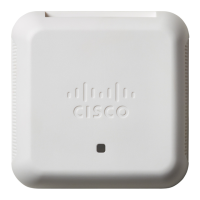
